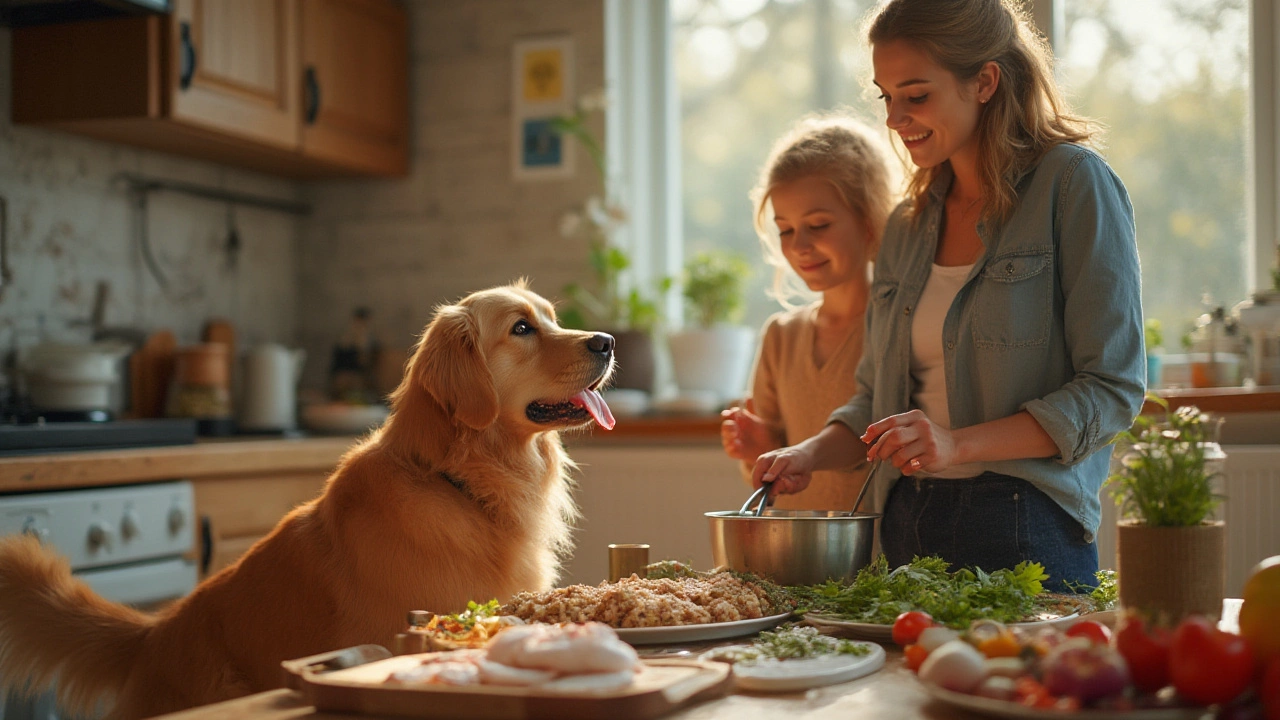Ever watched your dog scarf down meat scraps like they haven’t eaten in days? Ground chicken might seem like a dream for pups and owners alike—tasty, easy to prep, a high-protein fix that feels healthier than the mystery stuff in some kibble bags. But does ground chicken live up to the hype as a safe, nutritious staple for your dog’s bowl? There’s more to it than tossing raw meat into their dish and watching tails wag. If you’re even a little curious about DIY dog food or just want to know what that wag means when the frying pan comes out, let’s unpack the secrets, benefits, and raw truths about ground chicken for your furry best friend.
Why Chicken Is Popular in Dog Diets
Walk down any pet food aisle and you’ll notice a theme: chicken in cans, kibbles, treats—you name it. There’s a reason for this feathered frenzy. Chicken packs a ton of protein, which dogs need to build strong muscles, keep their coats shiny, and power through zoomies. It’s low in fat (compared to cuts like beef or lamb), so chicken-based foods make sense for weight-conscious dogs or those prone to tummy issues. Even picky eaters seem to drool over it. The widespread use isn’t just about taste; it’s about allergies too. While food allergies are a headache with dogs (itchy skin, upset stomachs), chicken is less likely to cause a reaction compared to beef, dairy, or wheat—the heavy hitters for hypersensitivity. But not every pup is the same. In a 2023 study by the American Kennel Club, about 15% of dog allergies could still be traced to chicken protein. So, monitoring for odd symptoms is always smart when switching proteins.
Chicken is also a lean source of critical nutrients. It’s loaded with B vitamins (like niacin and B6), vital for metabolism. Chicken also delivers zinc, essential for immune function, and phosphorus, which your dog’s bones rely on for strength. What sets ground chicken apart from, say, chicken breast cubes? The grinding process blends muscle meat (the best part for dogs) and sometimes a bit of skin or dark meat, giving a better balance of flavor and fat that most dogs adore. Just don’t confuse fresh ground chicken with highly processed stuff; avoid products with onion, garlic, excess salt, or seasoning blends that can quietly upset your pup’s digestive system or trigger toxicity.
Wondering why the sudden boom in homemade chicken meals for dogs? COVID-19 lockdowns saw a jump in dog ownership and, with that, more pawrents wanting total control over their pet’s bowls. Chicken fits the bill for cost, convenience, and flexibility. No wonder chicken-based dog food sales shot up by roughly 10% in 2023, according to pet industry reports. But what about raw versus cooked? Some raw food advocates swear by ground chicken diets, but the risks, like salmonella, can outweigh the perks if you’re not strict about food safety. We’ll talk more about that in the next section.
Health Benefits and Potential Risks of Ground Chicken
Dogs evolved as scavengers, but their guts don’t always match their wild ancestors’. Ground chicken, when properly cooked, is an easy-to-digest protein source. Compare that with fattier meats, and you’re likely sparing your dog’s waistline while fueling muscles. But nutrition isn’t just about protein. Ground chicken brings amino acids dogs can’t make themselves—like taurine, crucial for heart health, or tryptophan, which supports brain function. If you want a healthy dog (and who doesn’t?), getting those amino acids into their daily meals is non-negotiable.
But there’s a catch—raw chicken can pack a bacteria punch. Salmonella and Campylobacter don’t care if you’re fur or flesh; they’ll sicken both dogs and humans. The American Veterinary Medical Association warns that raw-fed dogs shed these bacteria, putting families at risk. Cooking ground chicken to an internal temperature of 165°F (74°C) kills the nasties, making it far safer for everyone. If you’ve heard “my dog never gets sick from raw,” remember: dogs are tough, but not invincible. Immune-compromised pups, puppies, or older dogs are especially vulnerable. There was even a report in early 2025 of a raw dog food-linked salmonella outbreak affecting kids in three U.S. states. Nobody wants a side of hospital with their homemade meals.
Another issue with ground chicken is nutrient imbalance. It’s naturally low in calcium, so if you feed chicken exclusively, you risk nutritional deficiencies. Dogs who eat only ground meat without bones can develop lifelong health issues—weak bones, seizures, heart problems. The fix? If you’re making your own meals, add a balanced calcium source. Crushed eggshells (one teaspoon per pound of meat) or a vet-recommended supplement usually does the trick. Here’s a comparison for common nutrients in various proteins, just so you can see how ground chicken stacks up:
| Protein Source | Calories (per 100g) | Protein (g) | Fat (g) | Calcium (mg) |
|---|---|---|---|---|
| Ground Chicken | 143 | 17 | 8 | 11 |
| Ground Beef (85%) | 215 | 18 | 15 | 12 |
| Chicken Breast (no skin) | 120 | 22 | 2.5 | 13 |
| Turkey (ground, 93%) | 155 | 19 | 8 | 9 |
If your dog needs to lose weight, chicken offers fewer calories and less fat compared to beef. On the other paw, beef still brings a touch more iron and zinc. A vet can advise if chicken should be your dog’s main meat or just one building block in a balanced menu.

How to Prepare Ground Chicken for Dogs: Safe Practices & Smart Add-Ons
Start with this: skip the seasonings. Cooking for your dog isn’t a master-chef challenge; plain and simple wins every time. Raw meat fans swear by the simplicity, but unless your vet instructs otherwise, cooked ground chicken is the safest bet. You don’t need fancy tools. Just a solid pan (non-stick works magic), a meat thermometer, and some time. Here’s how to do it right:
- Break up the ground chicken and cook it over medium heat until there’s no pink left.
- Drain off extra fat for leaner results—perfect for chubby pups or dogs with pancreatitis risk.
- Don’t add onions, garlic, heavy spices, or extra salt—dogs’ bodies just can’t handle these, and they’re toxic in big enough amounts.
- Check the internal temp: a steady 165°F (74°C) ensures safety.
Chicken can act as the meal’s main attraction or a topper to encourage picky eaters. Some dog parents use ground chicken to sneak in meds or supplements their pups won’t touch otherwise. Want a pro move? Add cooked peas, pumpkin puree, or sweet potatoes for fiber and vitamins. Toss in a bit of plain, unflavored yogurt (zero xylitol) and you’ll boost probiotics and calcium—just right for gut health. And always measure. One cup of cooked ground chicken has about 35 grams of protein. For a 30-lb dog, this covers a big chunk of their daily needs, but don’t wing it; overdoing protein can tax older dogs’ kidneys. Think balance, not bulk.
If you’re prepping meals in bulk, freeze portions in airtight containers. Defrost only what you’ll use in 1–2 days—bacterial growth speeds up once defrosted. Speaking of bacteria, wipe down counters and bowls after every meal. Wash your hands—a dog’s love is strong but not that strong if it leads to food poisoning. Got a tiny breed? Chop chicken even finer or mix with mushy rice, which eases digestion and is a classic recovery meal after an upset stomach.
Thinking about store-bought ground chicken? Always check the ingredient label. Some companies sneak in fillers or even pieces of bone too sharp for small dogs. Buy from reputable sources, ideally those that supply products designed specifically for pets if you’re nervous about contamination. Lastly, always introduce ground chicken in small amounts. New foods can upset bellies, even with “gentle” meats. Gradually mix into regular meals over 3–5 days.
Common Mistakes, Allergy Watchouts, and When to Call the Vet
Now, let’s get real. Even the best-made kitchen plans hit speedbumps. One is assuming all dogs thrive on chicken. Some pups actually develop chicken allergies after years of eating it (itchy paws, chronic ear infections, rumbly bellies—sound familiar?). If you notice red flags, swap to a different protein, and bring your dog to the vet for bloodwork. Rotating proteins not only spices up your dog’s menu but can also keep allergies at bay long-term. Some holistic vets suggest switching main proteins every few months to “challenge” the immune system in a gentle way.
Make no mistake: raw or undercooked chicken is the number one dog food mistake. In 2024, a survey by the UK’s Pet Food Manufacturers’ Association showed 1 in 5 dog owners fed their pet raw chicken at least once per week. That’s a potential bacteria wave right in your kitchen. And while the majority of cases don’t end in disaster, the risks go up if you live with children, elderly relatives, or immunosuppressed folks. Hygiene matters tenfold with raw animal products—think separate utensils and a cleaning routine worthy of a germaphobe.
Here’s a biggie: ground chicken doesn’t provide certain vitamins (like vitamin E or trace minerals like copper) on its own. If you want to do full-blown home cooking for your dog, partner with a vet nutritionist. They can build menus that fit your dog’s age, breed, and health quirks—no guesswork, no nutrient gaps. Many kibble-fed dogs get core nutrients from commercial mixes, but if you add ground chicken regularly, calculate the calories and nutrients to avoid an unbalanced diet. Too much goodness in one area means a shortfall somewhere else, and dogs can’t communicate a vitamin shortage the way kids can (the symptoms are subtle, like lethargy or skin problems).
One last tip: watch out for bones. Ground chicken meant for humans rarely includes sharp bone pieces, but ground poultry labeled for pets sometimes does, especially if it’s “raw blend.” Tiny splinters can cause choking or perforate intestines, which is a fast track to expensive vet bills and a lot of stress. For maximum safety, stick to boneless ground chicken or consult your vet if you’re unsure what’s safe for your specific dog.
If your dog throws up, gets diarrhea, acts tired, or you spot blood after trying ground chicken, hit up the vet without delay. Most cases clear up fast, but early care is the best way to dodge serious complications. On the upside, most dogs bounce back fast from diet switches—ground chicken is gentle, widely tolerated, and loved by both pups and humans who cook for them. Want to treat your best friend? A little ground chicken (cooked, plain, in moderation) just might be the best way to say “I love you” in dog language.
